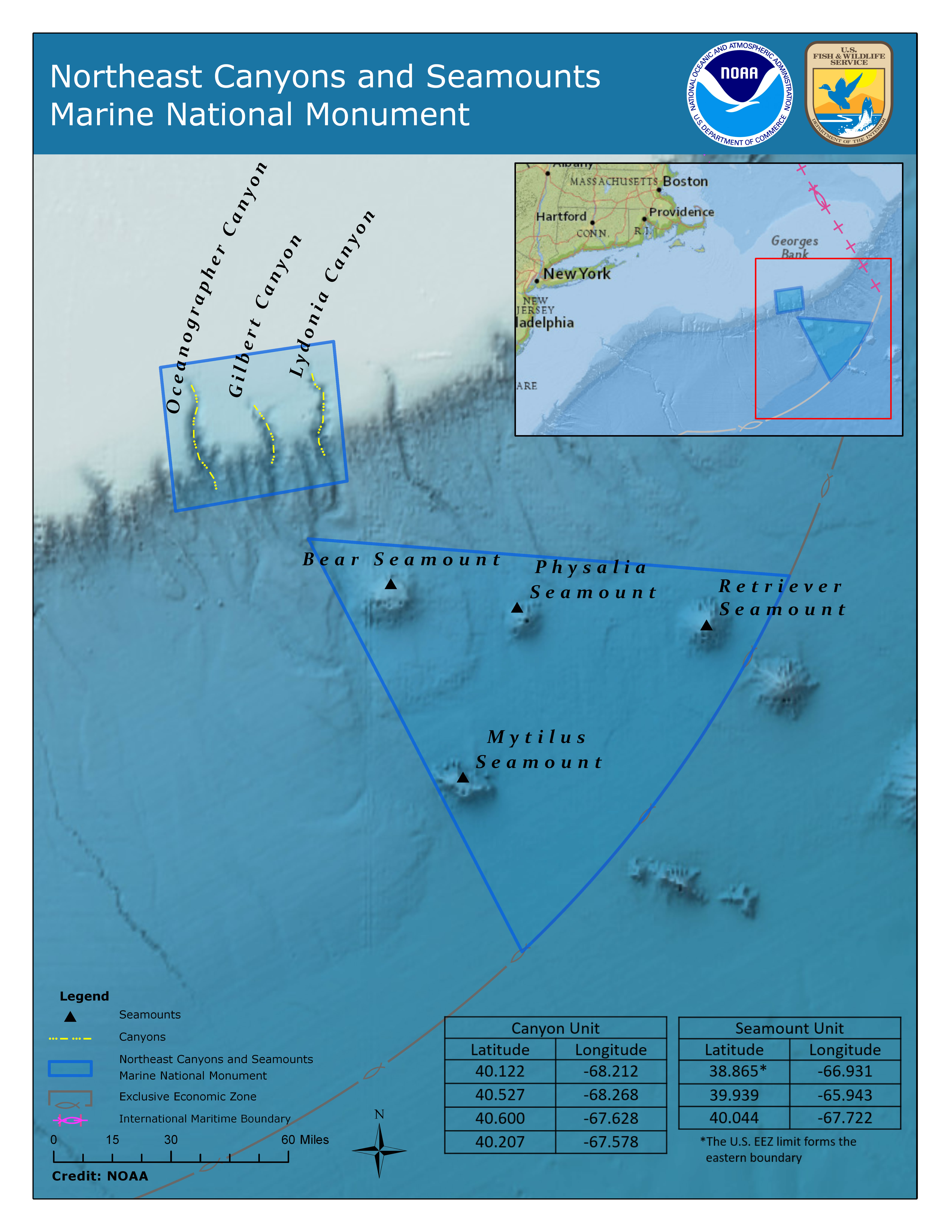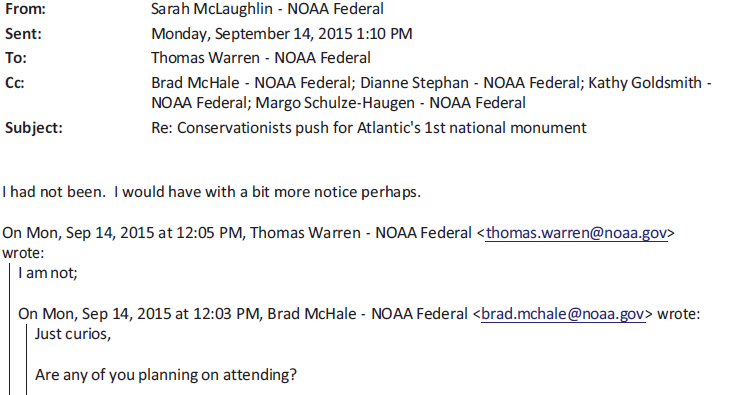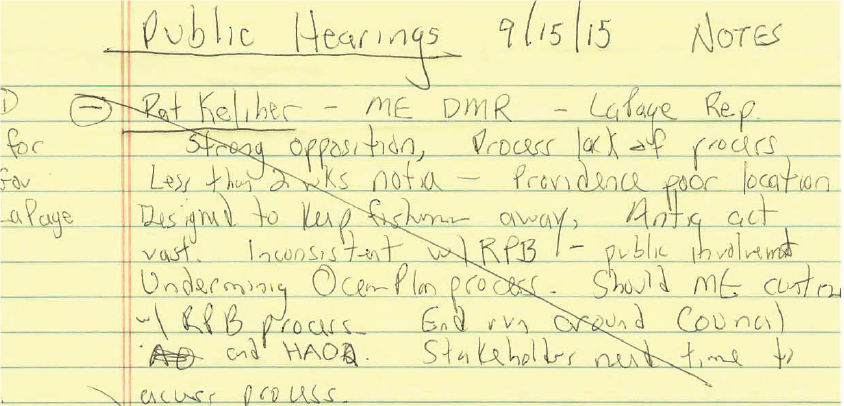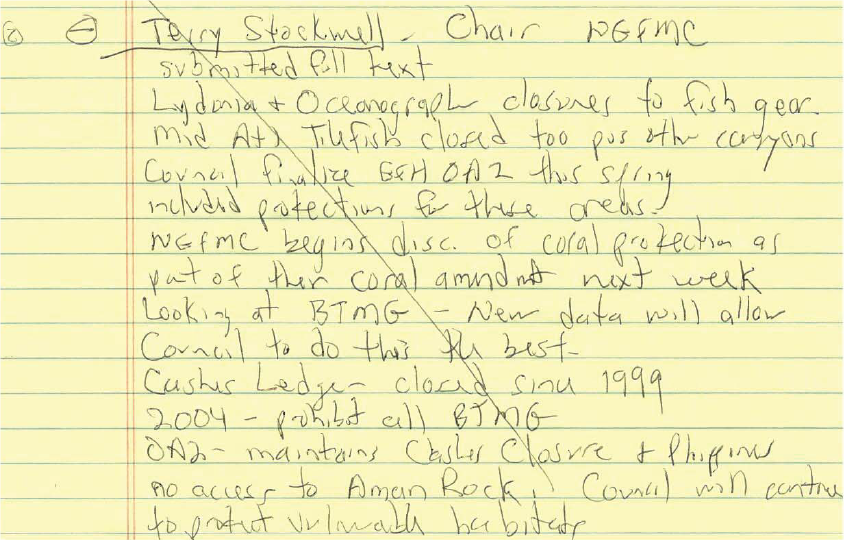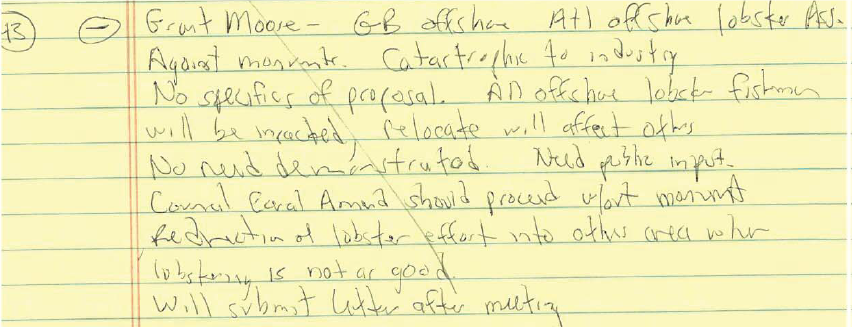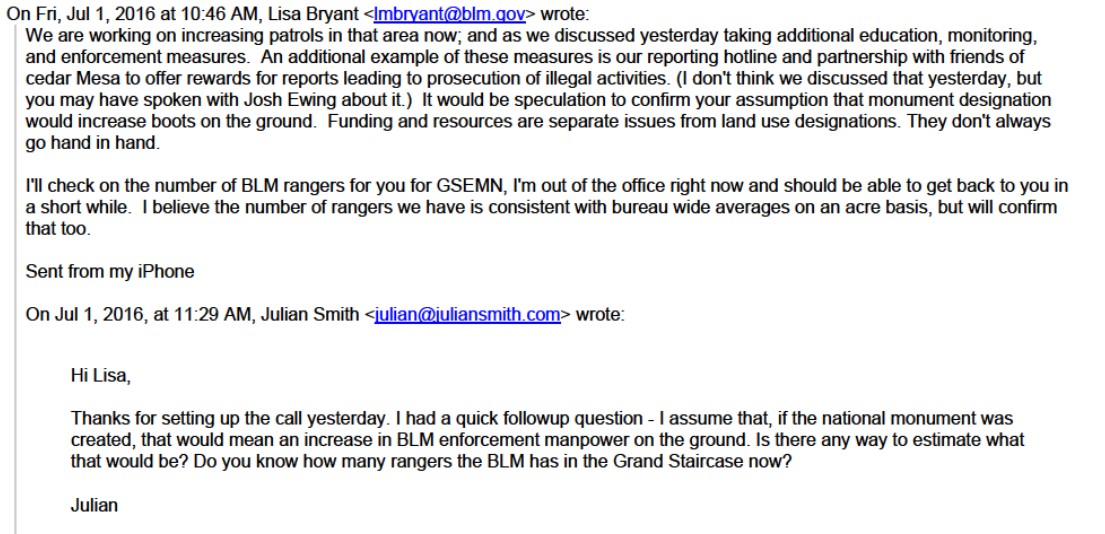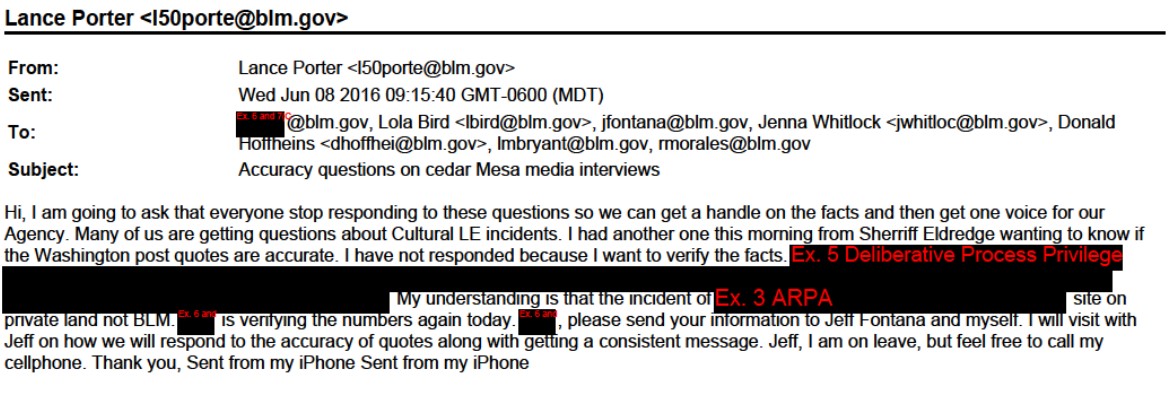On October 9, 2019, the White House issued two executive orders designed to curtail the abuse of guidance documents by government agencies. Both orders address due process violations by agencies by requiring notice and an opportunity to be heard before action can be taken or liability imposed against alleged wrongdoers. Learn More
FTC v. Vylah Tec: Magistrate Orders FL AG to Produce 30(b)(6) Witness for Second Time
Court cites improper behavior and objections in first depositions, allows for new deposition in ongoing “Cupo Case”
A Federal District Court ruled partially in favor of Cause of Action Institute’s motion for sanctions against the state of Florida, instructing a Florida assistant attorney general to re-appear for the second time at a new deposition due to the improper and invalid objections made during the first deposition.
“Nobody is above the law. Even lawyers working at the Florida Attorney General’s Office who appear as witnesses in depositions must follow the same rules as any other witness,” said Cynthia Crawford, senior counsel at Cause of Action Institute. “This case boils down to government officials who aggressively used their powers to unfairly crackdown on a family business by using questionable techniques and procedures and then tried to stonewall questions about the case they have brought. We hope the government will be more forthcoming and cooperative in the second deposition as we seek to defend our client and resolve this dispute.”
In August 2018, a Federal Court denied Florida’s motion for a protective order in which it tried to prevent Cause of Action from examining Florida’s role in the raid and prosecution of Vylah Tec LLC. In September, a senior assistant attorney general was selected to sit as the “30(b)(6)” witness for the state of Florida.
The Court ruled that the Florida Office of Attorney General “improperly instructed [the witness] not to answer numerous other questions posed by defense counsel.” In some instances, the Florida Office of Attorney General refused to cite a reason for their objection, as required. The Court also noted that instructions to the witness not to answer on the basis that “the document speaks for itself,” were improper.
As a result, the Court granted the defense a new deposition on limited topics, instructing the State to re-appear.
Parties have until Friday, Dec. 14, 2018, to hold a new deposition.
The Vylah Tec case demonstrates the vast power of the federal government and the ability of the Federal Trade Commission (FTC) to use a court order obtained in secret to deny a family-run company due process by swooping in and seizing assets—including the money they need to hire a lawyer and mount a defense. Cause of Action Institute firmly believes a prosperous society allows all individuals, entrepreneurs, and companies an opportunity to succeed, but far too often when facing the FTC, companies or individuals have their livelihoods threatened and must defend themselves against a regulatory authority with near endless resources and no motive to render justice.
Appellate Court Unfreezes Small Business Owner’s Assets After Being Wrongly Targeted by FTC
Washington, D.C. – The 11th Circuit Court of Appeals has ruled to unfreeze in part the assets of our client, Robert Cupo, who owns a small family-run tech support company, Vylah Tec, LLC (“V-Tec”), after the Federal Trade Commission (“FTC”) used misleading evidence to convince the lower court to grant a damaging injunctive order against his company. The ruling rejects the government’s clear overreach in not only freezing assets of the company, but also the joint marital assets of Mr. Cupo and his wife, and the assets of his brother who had no business connection to V-Tec. Cause of Action Institute (“CoA Institute”) filed an appeal of the district court’s order in September 2017.
CoA Institute Senior Counsel Cynthia Crawford: “The Government attempted to bulldoze Mr. Cupo and his family with punitive financial penalties before they had an opportunity to defend themselves. The preliminary injunction was granted based on faulty and mischaracterized evidence. That’s not due process, and it certainly is not justice. After nine long months of financial hardship, a large portion of the burden has finally been lifted, allowing our client to continue to fight to clear his name.”
The 11th Circuit found that the district court “did not make sufficient factual findings to support freezing these assets.”
Case Background:
V-Tec provides tech support to customers and also sells third-party antivirus and other data security software. In May 2017, the company’s headquarters was raided by FTC regulators, in conjunction with the Florida Attorney General’s office, on suspicion of “deceptive” sales practices.
To obtain the injunctive order that froze the Cupos’ assets, the FTC in court cited two examples of recorded calls that were both mischaracterized. The Government conceded that it submitted false evidence. Nonetheless, a Florida district court judge granted the injunctive order turning V-Tec’s operation over to a third-party receiver and freezing the assets of Mr. Cupo and several of his family members.
The 11th Circuit ruling vacates the asset freeze imposed against the assets held jointly by Mr. Cupo and his wife, as well as the asset held by his brother.
The full opinion can be found here.
For information regarding this press release, please contact Zachary Kurz, Director of Communications at CoA Institute: zachary.kurz@causeofaction.org.
Family Business Fights Back Against FTC, Files Appeal After Lower Court Wrongly Granted Injunctive Order
Washington, D.C. – Cause of Action Institute (“CoA Institute”) today filed its opening brief in the 11th Circuit Court of Appeals on behalf of a family-run tech support company, Vylah Tec, LLC (“V-Tec”), after the Federal Trade Commission (“FTC”) used misleading evidence to convince the lower court to grant a damaging injunctive order against the company. V-Tec is a small start-up, owned by Robert Cupo, that provides tech support to customers who have purchased electronic devices from the Home Shopping Network and other shopping channels. V-Tec also generates revenue from selling third-party antivirus and other data security software.
In May, the FTC, in conjunction with the Florida Attorney General’s office, raided the company’s headquarters on suspicion of “deceptive” sales practices, but were unable to uncover any concrete evidence of wrongdoing. In court, the FTC cited two examples of recorded calls that were both mischaracterized. A Florida federal judge granted the government’s request for a preliminary injunctive order (“PI”) that turned the company’s operation over to a third-party receiver and froze the assets of Mr. Cupo and several of his family members. In August, CoA Institute filed a motion to stay the district court’s order. While that decision is still pending, today’s brief is the first in CoA Institute’s appeal of the district court’s decision.
The brief states:
“The PI was granted without benefit of an evidentiary hearing, without application of the proper legal standard for issuing a preliminary injunction, and without application of the proper legal standard for analyzing the likelihood of success on the merits. It was based on untested and facially inadequate factual allegations.
“The Government has conceded that it submitted false evidence and mischaracterized other evidence it offered to the trial court, but it has done nothing to correct the record. To the contrary, the Government insists that the lower court and this Court condone its false evidence to crush a small business and to personally destroy its managers… The Government is seeking to bulldoze V-Tec before this Court can even rule on this appeal. That is not due process, and it certainly is not justice.”
CoA Institute Senior Counsel Cynthia Crawford: “The FTC’s facts in this case are either incomplete or patently false. Without evidence, it was wrong for the district court to grant an order that is draining V-Tec’s finances and destroying its reputation. We urge the 11th Circuit Court of Appeals to reexamine the flawed evidence and allow the Cupo family the due process they deserve, before their company is destroyed.”
The full brief can be found here
For information regarding this press release, please contact Zachary Kurz, Director of Communications at CoA Institute: zachary.kurz@causeofaction.org
FTC Destroying Family-Run Tech Support Business Without Evidence of Wrongdoing or Due Process
Washington, D.C. – Cause of Action Institute (“CoA Institute”) is stepping in to defend a small family-run tech support company, Vylah Tec, LLC (“V-Tec”), after the Federal Trade Commission (“FTC”) targeted the company and conducted an hours-long raid of the company’s headquarters on suspicion of “deceptive” sales practices. The raid was initiated as part of a politically-hyped campaign known as Operation Tech Trap headed by the FTC in conjunction with the Florida Attorney General’s office.
V-Tec is a small start-up owned by Robert Cupo that operates out of a single office in Fort Myers, Florida, and provides tech support to customers who buy electronic devices from the Home Shopping Network and other shopping channels. Individuals who purchase electronic devices such as laptops, printers and tablets are provided pre-paid tech support with their purchase. On top of its tech support operation, V-Tec also generates revenue from selling third-party antivirus and other data security software to customers who want additional security on their devices.
The FTC’s sting-like raid, assisted by local police, included hands-in-the air orders, the temporary confiscation of employee cell phones, and police-escorted bathroom breaks. One mother was told she could not leave to pick up her kids from daycare and police officers would use her phone to call and tell them she had been detained for questioning. Despite the hostile raid, FTC investigators were apparently unable to uncover any concrete evidence of wrongdoing by the company.
Nevertheless, a Florida District Court judge was sufficiently convinced by FTC lawyers to grant the government a preliminary injunctive order against V-Tec. This punitive process includes turning the company’s operation over to a third-party receiver and freezing the assets of the Cupo family members. CoA Institute has filed a motion to stay the District Court’s order.
CoA Institute Senior Counsel Cynthia Crawford: “When the government puts a company in its crosshairs, the process becomes the penalty. In this case, the court’s decision to allow an injunctive order is akin to using a sledgehammer to swat a fly. Freezing assets and turning the business over to a receiver is steadily draining V-Tec’s finances and destroying its reputation. Meanwhile the court’s action is harming the thousands of customers who are not receiving the support they paid for. We urge the court to reevaluate the flawed evidence FTC presented and stay this destructive order so that the Cupo family can have their day in court before the company is destroyed.”
In court, the FTC argued that V-Tec’s sales pitches for the software are deceptive, citing two examples of recorded calls. However, the FTC clearly mischaracterized its evidence and failed to support accusations fundamental to FTC’s case. Much of the evidence presented is either incomplete or incorrect. For example, the government in open court, played a portion of a tech support call that they wrongly alleged as deceptive “upselling.” What the government omitted, however, was that the technical support representative stayed on the phone after the customer declined to purchase additional software and addressed the caller’s problem.
A second transcript the FTC submitted in court mislabeled the so-called guilty party as a V-Tec employee, when in fact the person trying to harm the consumer did not actually work for V-Tec. A brief investigation of the call and the surrounding context would have made that clear. A V-Tec support representative actually protected the consumer in that instance, disconnecting the other individual from the call and disabling his remote access to the caller’s computer.
Instead of protecting consumers, the court’s injunction order is causing the most significant consumer harm. Since May 3, 2017, V-Tec has failed to answer over 100,000 customer calls. Many of these are likely customers with lifetime service contracts who, instead of receiving the product they paid for, are stuck in a never-ending hold loop. The order also froze assets of individuals with no actual stake in V-Tec. These individuals cannot access their savings and are struggling to pay for basic life expenses, or in one case, access funds of a wholly unrelated business.
The full motion for stay is available here.
For information regarding this press release, please contact Zachary Kurz, Director of Communications: zachary.kurz@causeofaction.org
Northeast Canyons and Seamounts Designation: Some Stakeholders Are More Equal Than Others
We began our series of blog posts by examining the history, purpose, and limitations of the Antiquities Act of 1906, 54 U.S.C. §§ 320301 – 320303 (“Antiquities Act” or the “Act”) (here and here), followed by a discussion of how the Act fits within the variety of other frameworks for protecting and using public lands (here and here) and the variety of statutory frameworks and federal government programs that are used to manage the jurisdictional waters of the United States. (here and here). We also shared a copy of the comment we submitted to the Department of the Interior in which we outlined our investigative activity relative to the Bears’ Ears National Monument. This week we review the procedural history of the designation of the Northeast Canyons and Seamounts Marine National Monument, also referred to here as the Atlantic Monument, which was made by President Obama on September 15, 2016 (“Proclamation”), and show that certain, privileged, non-governmental entities were granted access to detailed information on the forthcoming monument and allowed input into the designation, while other stakeholders—notably those with specific legal authority, such as Regional Fishery Councils—were denied input and access.
The Atlantic Monument includes the Oceanographer, Gilbert, and Lydonia canyons, which are located at the edge of the geological continental shelf, and the Bear, Physalia, Retriever, and Mytilus sea mounts, which are located farther offshore at the start of the New England Seamount chain.
The Proclamation provided the following justifications for the designation: (1) the historical value of the maritime trades, especially fishing, to the cultural roots of New England; (2) the abundance of deep sea corals, fish, whales, and other marine mammals; and (3) long-time scientific study of the area using research vessels, submarines, and remotely operated underwater vehicles for deep-sea expeditions.
The Proclamation purported to prohibit the following activities, effective immediately:
- Oil, gas, minerals, or other energy exploration, development, or production;
- Poisons, electrical charges, or explosives to collect or harvest a “monument resource;”[1]
- Releasing an “introduced species;”[2]
- Removing a “monument resource” except as provided under “Regulated Activities;”
- Construction or damaging submerged lands (except for scientific instruments or submarine cables);
- Commercial Fishing; and
- Possessing commercial fishing gear unless stowed during “passage without interruption” through the monument.
In addition, the following activities are to be regulated:
- Research and scientific exploration;
- Education, Conservation, and Management;
- Anchoring scientific instruments;
- Recreational fishing;
- Commercial fishing for red crab and American lobster for up to 7 years;
- Sailing, and bird or mammal watching; and
- Submarine cables.
Note that these restrictions do not apply to any person who is not a citizen, national, or resident alien of the United States, unless in accordance with international law. As we explained in our May 22, 2017 blog post, within the EEZ, in which the Atlantic Monument is located, the United States has only limited sovereign rights, and thus international law still applies, limiting the ability of an American President to extend prohibitions to non-Americans.
In light of the stated justification for the Atlantic Monument, it is curious that certain traditional, culturally-significant, and highly-regulated activities, such as commercial fishing, were prohibited; while others, such as recreational fishing, were to be regulated; and some, such as commercial fishing for red crab and American lobster, were granted a seven-year stay of execution—bearing in mind that none of these classifications or limitations even apply to non-Americans.[3] These discrepancies, as well as peculiarities in the procedural history of the Atlantic Monument, were among the bases for a series of FOIA requests that CoA Institute submitted in October 2016, in which we requested records from NOAA and the Council on Environmental Quality (“CEQ”) relating (among other things) to the designation of the Atlantic Monument and to the justification for the unequal treatment of stakeholders and the opaque process surrounding the designation of the Atlantic Monument. The submitted FOIA requests include the following:
- NOAA FOIA Request regarding the Rhode Island Town Hall Meeting;
- NOAA FOIA Request regarding potential Marine Monuments in the Atlantic;
- NOAA FOIA Request regarding Congressional Records;
- CEQ FOIA Request regarding the Antiquities Act; and
- CEQ FOIA Request regarding Third-Party Communications.
To-date NOAA and CEQ have released only a portion of the requested documents. However, even the initial interim releases show that, despite claims that the Atlantic Monument is the product of “an extensive year-long public process,” the designation of the Atlantic Monument was a predetermined decision that allowed for limited public input to appease public backlash.
The following history, derived from the partial responses to CoA Institute’s FOIA requests and other publicly available documents, is illustrative:
In March 2015, the Conservation Law Foundation (“CLF”) and Natural Resources Defense Council (“NRDC”) published an Issue Brief that advocated for “permanent protection” of New England’s canyons and seamounts. By July 2015, NOAA personnel in the Fisheries Service were already discussing the details of which activities should be prohibited post-Proclamation, such as whether the Proclamation should include an exception to the prohibition on fishing for highly migratory species (“HMS”), such as tuna, swordfish, marlin, and a variety of sharks. Although the discussion confirmed that neither commercial nor recreational fishermen of HMS anchor their boats ; and, in fact, most vessels do not carry enough anchor line for the depths in the area, ultimately HMS commercial fishing was prohibited.
In August 2015, the Conservation Law Foundation forwarded to NOAA an invitation to an event scheduled for September 2, 2015 at the New England Aquarium regarding deep sea canyons and seamounts located off the coast of Cape Cod and expressing commitment to “real and significant conservation in New England and . . . ensuring the timely completion of a good and effective ocean plan—the first in the U.S.” The message made no mention of the New England Regional Fishery Management Plan that had long been in place under the Magnuson-Stevens Act.
The following day, September 3, 2015, NOAA issued a broad invitation to participate in a Town Hall meeting scheduled for September 15, 2015—just 12 days after the announcement—to discuss “permanent protections” for three deep sea canyons and four seamounts off the coast of New England. The invitation did not mention designation of a National Monument nor that the meeting would be the only event at which to present feedback. It provided a deadline for submitting written comments to a special NOAA e-mail address, which was set for the same day as the Town Hall meeting. No proposal or details were included with the invitation.
It appears that certain privileged, non-governmental entities that had the inside track on the proposal, including the Pew Research Center and the Conservation Law Foundation, had more information about the proposal before the Town Hall meeting than NOAA was able, or willing, to make available to stakeholders. The lack of information available to local stakeholders hindered their ability to provide meaningful commentary.
NOAA, however, had prepared a briefing document as early as July 2015 that included much relevant information and identified the conflict between the monument proposal and the fishery management councils’ activities. The briefing document also “red flagged” the anticipated objections of various fishermen on the basis that their fishing was not harmful to the area. As of July 2015, the proposal allowed commercial pelagic fishing (i.e., fishing in the water column)—an activity that was ultimately forbidden.
Before the Town Hall meeting, NOAA was advised of specific shortcomings in the notice process that further compromised the ability of local stakeholders to provide meaningful input and that buttressed the impression that the entire process was undemocratic and designed to bypass the extensive multi-year effort to protect marine resources. For example:
- In contrast to NOAA’s standard practice of sending email messages from “@noaa.gov,” the e-mail message announcing the Town Hall meeting was sent from news@meltwaterpress.com, which led recipients to fail to recognize that the message included an important announcement and increased the potential for the message to be caught in a spam-blocker;
- In response to a request for information before the Town Hall meeting, the requester was told that no information beyond the press release was available and no additional briefings or public meetings were scheduled, in contrast to the typical process of holding 15-20 public hearings and providing information electronically.
….
- However, consistent with the experience of other stakeholders, on-line research of the proposal led to the Conservation Law Center and PEW websites, where electronic petitions were available along with inaccurate and misleading information.
- As a result of the patent deficiencies (whether by design or omission) in the public comment process, the writer requested from NOAA an extended comment period, additional public hearings, and detailed information on the specific proposed measures. It appears that no such opportunity for meaningful feedback was ever provided.
The lack of proper notice for the town hall meeting was not just a sticking point for fishermen who were unable to attend, but even created an impediment to attendance for NOAA personnel.
The lack of notice was a contentious issue at the Town Hall meeting, as was the Providence, Rhode Island location, which appeared to have been chosen to keep fishermen away.
By contrast, representatives of academia, Brown University and the University of Connecticut, and special interest groups, Pew and NRDC, remarked that they had already submitted written comments on the proposal. They, apparently, knew enough about the proposal before the meeting to draft comments and submit them ahead of time.
Others—notably fishermen and local businesses—were not privy to specifics of the proposal until they arrived at the Town Hall meeting, and, even then, were provided inadequate details.
The exclusion of the Fishery Management Council from meaningful input apparently was consistent with a desire by some to bypass the “too long” democratic process.
Comments by stakeholders with intimate knowledge of how the area is managed told a different story—the Lydonia and Oceanographer canyons were already closed to fishing gear . . .
. . . the Fishery Management Council process is based on science and abundant data . . .
. . . the Council process is rigorous. . .
. . .and the “pristine” condition of the areas shows that the areas have been well-managed.
Stakeholders who must actually live with the effects of the Atlantic Monument also commented that there are public impacts from the proposed monument—to jobs and other fishing areas that must be, and have not been, considered. As one commenter stated—there are lives at stake.
The full text of the statement of the New England Council Chairman, explaining the history of the Council’s actions, and the design of coral management zones, can be found here.
These spoken comments were consistent with written comments submitted immediately before or shortly after the Town Hall meeting.

Written comments provided after the hearing highlighted certain factual inaccuracies in the presentation in support of the monument, such as:
- The claim that there was increased fishing pressure in the designation areas when, in fact, the number of boats actually fishing had fallen dramatically (by 2/3 or more);
- The Annual Catch Limit is well below the Overfishing Limit;
- The fishing methods described at the September 2015 Town Hall meeting do not resemble the methods actually used;
- Sword fish and squid fishing gear does not come anywhere close to the bottom;
- Thousands of square miles of New England waters have already been closed to fishing via democratic process—in contrast to the undemocratic process used to designate the monuments.
Written comments also reiterated the complaint that the process of designating the monument lacked transparency, including:
- The lack of notice for the town hall meeting;
- The two-minute limit on oral comments;
- The lack of parameters (time frame, review process, etc.) for written comments;
- The lack of ability of NOAA staff to answer questions;
- The pervasive misrepresentation of existing environmental protections and conditions; and
- The lack of specifics on the proposal—no boundaries, no regulatory provisions, no depth contours, and no evidence of need or benefit to closing the area.
Meanwhile, as the fishermen were begging for due process and the Council was pleading to be allowed to do its job, it appears that the Administration was continuing to work with certain, privileged, non-governmental entities toward announcing the monument designation at the 2015 Our Oceans Conference, scheduled to take place in Valparaiso, Chile or October 5-6, 2015. Notably, this plan was known among the privileged entities before the Town Hall Meeting, a fact that they took care to keep quiet.
The “potential collusion” of these outside interests in the apparently pre-ordained monument designation was of concern to the U.S. House of Representatives Committee on Natural Resources, which held an oversight hearing on the potential designation of marine national monuments on September 29, 2015—only 6 days before the Our Oceans announcement was to take place.
Throughout 2016, objections to establishing a marine monument in the Atlantic were made by stakeholders who had intimate knowledge of the area as well as their life’s work at risk. Like the earlier commenters, they objected to the lack of transparency, democratic process, accurate data, and coordination with existing—and effective—management plans.
These calls went unheeded and the Atlantic Monument was proclaimed on September 15, 2016. Nevertheless, and notwithstanding the initial plan to announce its designation at the Our Oceans Conference in October 2015, throughout 2016, there remained considerable confusion within NOAA as to what the monument would entail, including very basic questions such as:
the types of fisheries that are in the monument area;
whether fishing permits are required, the term of fishing permits, and the effect of the designation on existing permits;
whether conditions could be placed on permits by NOAA, or whether a rule-making would be required
Ultimately, they concluded that a rulemaking would be required:
The need for a rulemaking also raises the critical question of whether the Administration ever had the legal authority to implement a monument in the Atlantic Ocean in the first place. But, more on that later . . . Our series will continue next week with an analysis of the legal issues arising from the imposition of a Marine National Monument in an area that is already subject to a comprehensive regulatory scheme.
Any questions, commentary, or criticisms? Please e-mail us at kara.mckenna@causeofaction.org and/or cynthia.crawford@causeofaction.org.
Cynthia F. Crawford is a Senior Counsel at Cause of Action Institute.
Kara E. McKenna is a Counsel at Cause of Action Institute. You can follow her on Twitter @Kara_McK
[1] This term is not defined in the Proclamation.
[2] This term is not defined in the Proclamation.
[3] Citizen, national, or resident alien of the United States.
Antiquities Act Review – Bears Ears and Beyond
We recently began our series of blog posts examining the history, purpose, limitations, and the Trump administration’s review of the Antiquities Act of 1906, 54 U.S.C. §§ 320301 – 320303 (“Antiquities Act” or the “Act”). This week we discuss the status of President Trump’s Executive Order on the Review of Designations Under the Antiquities Act.
As discussed in our previous posts, the Antiquities Act permits a president to proclaim “historic landmarks, historic and prehistoric structures, and other objects of historic or scientific interest” as national monuments. To protect these objects, the President also is permitted to “reserve parcels of land as part of the national monument” subject to the limitation that “the parcels are confined to the smallest area compatible with proper care and management of the objects to be protected.[1]
On April 26, 2017, President Trump signed the Executive Order on the Review of Designations Under the Antiquities Act (“Antiquactities Act E.O.”), which directs the Secretary of the Interior to review all national monuments created by the Antiquities Act since January 1, 1996 that measure more than 100,000 acres or lacked appropriate public input. In addition, review of some Marine National Monuments are the subject of section 4 of the April 28, 2017 Executive Order on Implementing an America-First Offshore Energy Strategy (“Offshore Energy E.O.”).
In conducting its review of these national monuments, the Department of Interior is seeking public comments related to the seven considerations set forth in the Antiquities Act E.O.: (1) whether the monument designations are limited to “the smallest area compatible with the proper care and management of the object to be protected”; (2) whether the designated lands are “historic landmarks, historic and prehistoric structures, [or] other objects of historic or scientific interest” within the meaning of the Act; (3) the impacts of designations on the use of Federal lands; (4) the impacts of designations on non-Federal inholdings or lands near the monument boundaries; (5) concerns of “State, tribal, and local governments affected by the designation”; (6) whether there are sufficient Federal resources to manage the designated lands; and (7) other factors deemed appropriate by the Secretary.
Comments related to the Bears Ears National Monument in Utah closed on May 26, 2017. Comments related to all other national monuments are open until July 10, 2017. Pursuant to the Antiquities Act E.O., the Secretary of the Interior must provide an interim report regarding Bears Ears by June 10, 2017 and a final report on all monuments under review by August 24, 2017. The Offshore Energy E.O. requires a final report from the Secretary of Commerce regarding certain Marine National Monuments by October 25, 2017.
Cause of Action Institute (“CoA Institute”) submitted comments regarding Bears Ear National Monument on May 26, 2107. Our comments, which can be read here focused on several key issues, such as the lack of transparency in the monument designation process and the lack of sufficient Federal resources to manage the designated lands.
Several days after submitting our comments, CoA Institute received the first installment, totaling some 1,300 records, in response to one of our two Freedom of Information Act (“FOIA”) requests seeking records related to Bears Ears National Monument. That FOIA request was based on conversations with local stakeholders and publicly available reports and sought, among other things, records relating to incidents of looting, vandalism, and damage to antiquities located on Bureau of Land Management-held (“BLM”) lands in San Juan County, Utah that ultimately were included as part of Bears Ears National Monument on December 28, 2016.
Several of the responsive records released to CoA Institute substantiate the concerns we raised in our May 26, 2017 comments. First, in regards to Federal resources to manage the designated lands, the records demonstrate that there are, at most, only two BLM rangers who patrol the entire million-plus acres of BLM-administered land in San Juan County. This is roughly the same number of BLM Rangers who patrol the approximately 2.5 million acres in Grand Staircase Escalante National Monument and the BLM Kanab Field Office.
Read the released emails here
Although Bears Ears also has a significant number of volunteers who act as site stewards, the released records show that patrolling these vast resources is complicated. For example, responding to incidents that occur at archaeological sites requires not just BLM Rangers, but also BLM archaeologists to assess damage and remediate as necessary. In some instances, Rangers and archaeologists can only access the damaged sites with the aid of climbing equipment. Because BLM does not have policies or certifications related to rock climbing or repelling and thus may not have qualified personnel on site, some of these investigations have been barred from proceeding. Resources to patrol and protect this area were and continue to be an issue, as stated by a BLM employee in response to a question assuming that monument designation would confer additional law enforcement resources: “Funding and resources are separate issues from land use designations. They don’t always go hand in hand.”
Read the released emails here
In our comments regarding Bears Ears, CoA Institute also highlighted the lack of transparency in the monument designation process and suggested several remedies for addressing transparency concerns moving forward, including releasing information regarding incidents of looting and vandalism of antiquities on the lands reserved as part of the monument. The documents released to us last week illustrate why this is necessary. In the months prior to the creation of the Bears Ears National Monument, there were conflicting reports regarding the number of incidents of looting and vandalism in the proposed monument area. Individuals on both sides of the monument advocacy efforts used these conflicting reports to their own ends, adding additional confusion to an already heated debate.
Read the released emails here
The confusion regarding incident reports was also apparent within the BLM itself—not because BLM did not have the data regarding the incidents, but rather because it did not have an efficient, timely reporting mechanism in place to make such information easily retrievable.
As the Secretary of the Interior continues his review of recent monument designations, CoA Institute will continue to examine and release records relevant to this effort as they are received.
Any questions, commentary, or criticisms? Please e-mail us at kara.mckenna@causeofaction.org and/or cynthia.crawford@causeofaction.org
Cynthia F. Crawford is a Senior Counsel at Cause of Action Institute.
Kara E. McKenna is a Counsel at Cause of Action Institute. You can follow her on Twitter @Kara_McK
